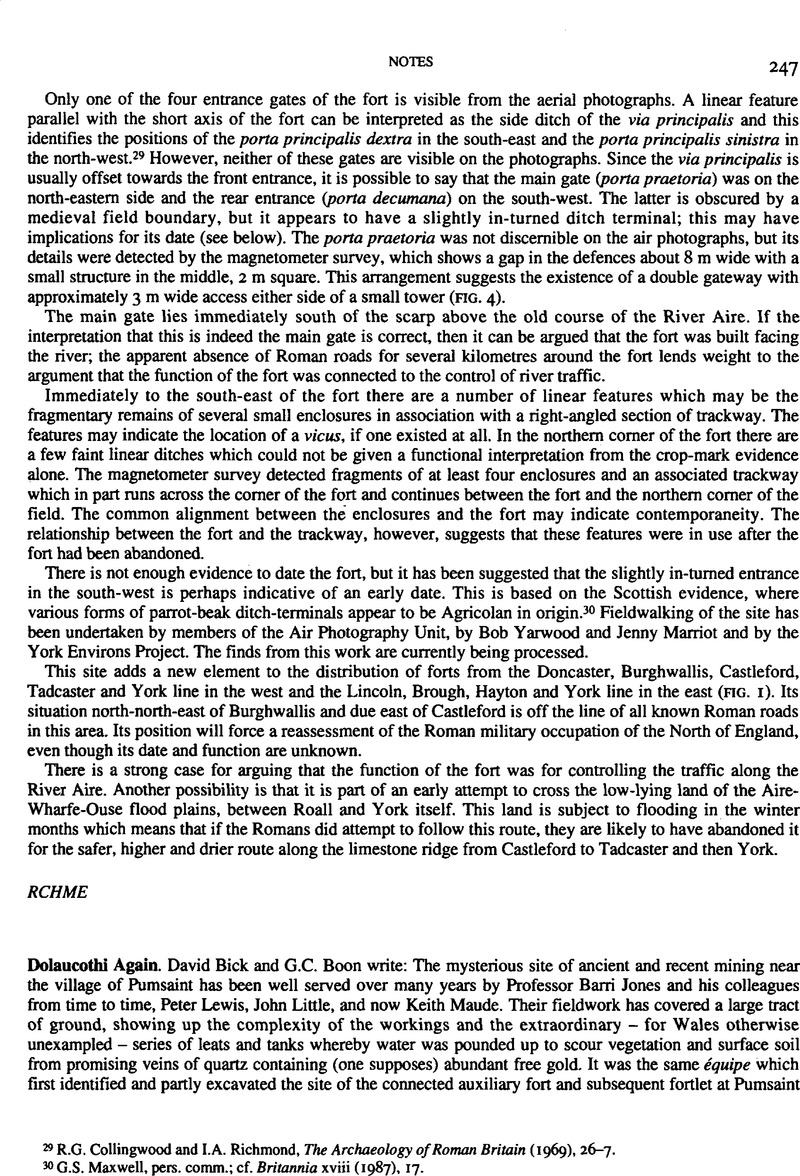No CrossRef data available.
Article contents
Dolaucothi Again
Published online by Cambridge University Press: 09 November 2011
Abstract

- Type
- Notes
- Information
- Copyright
- Copyright © David Bick and G.C. Boon 1993. Exclusive Licence to Publish: The Society for the Promotion of Roman Studies
References
31 Finds from the left-hand side of the riverbank, as one approaches Pumsaint from the direction of the mine, made by the late J.F. Jones, are published in Boon's paper on non-ferrous mining in Britain, Roman, Apulum ix (1971), 500Google Scholar and fig. 50. Not mentioned is a mortarium-rim stamped FLVGVD. The tiny piece of a monumental inscription is also published in Britannia i (1970), 307, no. 11.Google Scholar Finds from the right-hand side are published by B. and H. Bumham in Carms. Antiquary xxii (1986), 3–13Google Scholar, with pottery listed by P.V. Webster. The same note also includes a useful bibliography. Boon's strong recollection is that street-metalling within the fort, in the area opened in 1972, was composed of milled quaitz. This is not mentioned in the interim reports by Jones and Little (Carms. Antiquary ix (1973), 3–27Google Scholar; x (1974), 3-16), but if correctly noted would of course link the garrison with mining-activities very intimately.
32 Boon, and Williams, , JRS lvi (1966), 125Google Scholar, cf. fig. 6. A section of such a wheel from the Rio Tinto mines may be seen in the Greek and Roman Life gallery of the British Museum.
33 Bick, D., Arch, in Wales xxx (1990), 33–4.Google Scholar
34 Bick, D., Arch, in Wales xxviii (1988), 20–1Google Scholar. Jones and Maude have interpreted this discovery as an extension of the ‘Annell aqueduct’, the question of tapping the abundant waters of the Annell now being ignored.
35 B., and Burnham, H., Arch, in Wales xxx (1990), 55.Google Scholar
36 Jones, G.D.B. and Lewis, P.R., Antiq. Journ. xlix (1969), 254, pl. xlviiic.Google Scholar
37 Jones, G.D.B. et al. Bull. Board of Celtic Stud, xix (1961), 71–84.Google Scholar
38 The reference in Britannia xxii (1991), 210Google Scholar to ‘a satellite industry carving cornelian gemstones’ cannot be left as it is. There is a single intaglio from Dolaucothi, a ring-stone in nicolo, not cornelian, showing a satyr; it is an old find, and because it was attached by natural concretion to a small pebble has erroneously been represented for very many years as indicative of gem-cutting on the spot. The only cornelian is a plain oval slip in the remains of a handsome hinged gold bracelet, a component of the 1796–7 hoard of gold jewellery found in a field behind the mansion of Dolaucothi (British and Carmarthen Museums, the ensemble shown by Nash-Williams, V.E., Bull. Board of Celtic Stud, xiv (1952), 81–2Google Scholar, pl. v. See also BM Cat. Jewellery Greek Etruscan and Roman (1911), Nos 2741–2, 2787–8). Lead isotope analysis, which could not be arranged some years ago though gold from Dolaucothi was available, would be well worth attempting in the hope of deciding whether these ornaments were of local gold and hence, perhaps, local manufacture.
39 Arch. Camb. cxxviii (1979), 165.Google Scholar
40 Archaeology in Wales xxviii (1988), 20.Google Scholar
41 Britannia xxiii (1992), 358.Google Scholar




